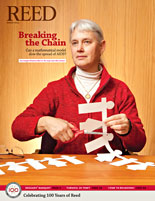
IRIS login | Reed College home Volume 91, No. 1: March 2012
Remembering Helen Stafford
I was saddened to read in the December issue of the death of Professor Helen Stafford [biology 1954–87].
I was among the earliest of the Reed students over whose career Dr. Stafford had a major influence. In 1956–57, I took the introductory biology course as a junior physics major. She asked me one day, knowing I was a physics major, if I knew anything about solar batteries, since one of the well-known researchers in photosynthesis—and a future Nobel Prize winner—had just proposed that light harvesting in photosynthesis worked like a solar battery. I’m not sure I was ever able to explain it to her, but I ended up taking both her plant evolution and plant physiology courses and did my senior thesis on photoconductivity of plant chloroplasts. I was pleased that she signed the thesis approval page along with Professor William Parker [1948–79], my physics thesis adviser. I suffered comments from both ends of the basement of Eliot Hall, where the biology and physics labs were located at the time, as I rushed the chloroplast preparation from Dr. Stafford’s lab to my apparatus in the senior physics lab.
Helen also introduced me to Stacy French, then director of the Carnegie Institution of Washington’s plant biology lab, where I spent two summers as an assistant and continued some of my Reed thesis research. I went on to a career in academia, pursuing research on the light-harvesting process of photosynthesis and teaching biology, plant physiology, and plant biophysics, all the consequence of that initial short conversation.
One of the personal things I remember to this day is the twinkle in her eye and wry smile as she posed a thought-provoking question for me to ponder.


LATEST COMMENTS
steve-jobs-1976 I knew Steve Jobs when he was on the second floor of Quincy. (Fall...
Utnapishtim - 2 weeks ago
Prof. Mason Drukman [political science 1964–70] This is gold, pure gold. God bless, Prof. Drukman.
puredog - 1 month ago
virginia-davis-1965 Such a good friend & compatriot in the day of Satyricon...
czarchasm - 4 months ago
John Peara Baba 1990 John died of a broken heart from losing his mom and then his...
kodachrome - 7 months ago
Carol Sawyer 1962 Who wrote this obit? I'm writing something about Carol Sawyer...
MsLaurie Pepper - 8 months ago
William W. Wissman MAT 1969 ...and THREE sisters. Sabra, the oldest, Mary, the middle, and...
riclf - 10 months ago